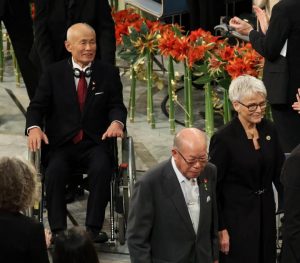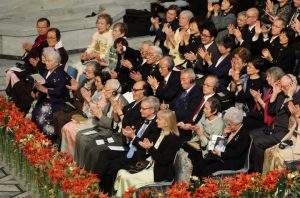Hidankyo’s Toshiyuki Mimaki takes stage, carrying in his heart the perseverance of deceased predecessors on difficult path toward nuclear abolition
Dec. 11, 2024
OSLO — by Michio Shimotaka, Staff Writer
On December 10, at the Nobel Peace Prize award ceremony held in Oslo City Hall in Norway, Toshiyuki Mimaki, 82, co-chair of the Japan Confederation of A-and H-Bomb Sufferers Organizations (Nihon Hidankyo) and chair of the Hiroshima Prefectural Confederation of A-bomb Sufferers Organizations (Hiroshima Hidankyo) who lives in the town of Kitahiroshima-cho, took the stage to receive the award certificate. Many of his predecessors who, from the A-bombed Hiroshima, called for a world without nuclear weapons and war have died without witnessing either the awarding of the prize or the abolition of nuclear weapons. “We must never give up,” said Mr. Mimaki, renewing his determination as he looked back at his group’s path of hardship.
Amid the solemn atmosphere, Mr. Mimaki, in a wheelchair and wearing a black suit, entered the ceremony venue, bowing occasionally to people on the way. Nodding his head, he intently listened to remarks by Jørgen Frydnes, chair of the Norwegian Nobel Committee. Urged along, Mr. Mimaki proceeded to center stage with a serious expression, holding back tears as he received the award certificate.
Mr. Mimaki’s involvement in the A-bomb survivor (hibakusha) movement began seriously around 20 years ago. Since the prize announcement was made, he repeatedly mentioned how Hidankyo was awarded the prize “at a time when I just happened to be the co-chair.” Looking at a photograph taken at the time of the inaugural meeting of the Hiroshima Hidankyo organization at the Hiroshima YMCA Hall in the area of Motomachi (in Hiroshima’s present-day Naka Ward), he reflected on the “considerable hardships of which I know nothing” experienced by Ichiro Moritaki (who died in 1994), the first chair of the group, and Mr. Moritaki’s contemporaries.
With his innate drive and passion, which served him well when he served as a town council member, Mr. Mimaki became in a position to lead the A-bomb survivors’ movement. He lamented the reality that people would pass him by without showing interest when he was on the street collecting signatures to call for the Japanese government’s participation in the Treaty on the Prohibition of Nuclear Weapons (TPNW). He came to the award ceremony with the expectation that, “From Oslo, the hopes of the hibakusha can probably be communicated to the world, even if only somewhat.” Mr. Mimaki reaffirmed for himself the spirit of “never give up,” which he had learned from Sunao Tsuboi, former chair of Hiroshima Hidankyo who died in 2021. He and Mr. Tsuboi used to work together both in Japan and overseas.
Also in attendance at the ceremony were two Nihon Hidankyo directors — Satoshi Tanaka, 80, a resident of Hiroshima City’s Nishi Ward, and Emiko Honma, 74, a resident of Matsue City — who strengthened their resolve for future work through the event. Watching on at the ceremony were Keiko Ogura, 87, an A-bomb survivor living in the city’s Naka Ward who is scheduled to provide testimony in Oslo about her experience in the atomic bombing on December 11, and Natsuki Kai, 17, a High School Peace Ambassador and second-year student at Motomachi High School who lives in Nishi Ward.
(Originally published on December 11, 2024)
On December 10, at the Nobel Peace Prize award ceremony held in Oslo City Hall in Norway, Toshiyuki Mimaki, 82, co-chair of the Japan Confederation of A-and H-Bomb Sufferers Organizations (Nihon Hidankyo) and chair of the Hiroshima Prefectural Confederation of A-bomb Sufferers Organizations (Hiroshima Hidankyo) who lives in the town of Kitahiroshima-cho, took the stage to receive the award certificate. Many of his predecessors who, from the A-bombed Hiroshima, called for a world without nuclear weapons and war have died without witnessing either the awarding of the prize or the abolition of nuclear weapons. “We must never give up,” said Mr. Mimaki, renewing his determination as he looked back at his group’s path of hardship.
Amid the solemn atmosphere, Mr. Mimaki, in a wheelchair and wearing a black suit, entered the ceremony venue, bowing occasionally to people on the way. Nodding his head, he intently listened to remarks by Jørgen Frydnes, chair of the Norwegian Nobel Committee. Urged along, Mr. Mimaki proceeded to center stage with a serious expression, holding back tears as he received the award certificate.
Mr. Mimaki’s involvement in the A-bomb survivor (hibakusha) movement began seriously around 20 years ago. Since the prize announcement was made, he repeatedly mentioned how Hidankyo was awarded the prize “at a time when I just happened to be the co-chair.” Looking at a photograph taken at the time of the inaugural meeting of the Hiroshima Hidankyo organization at the Hiroshima YMCA Hall in the area of Motomachi (in Hiroshima’s present-day Naka Ward), he reflected on the “considerable hardships of which I know nothing” experienced by Ichiro Moritaki (who died in 1994), the first chair of the group, and Mr. Moritaki’s contemporaries.
With his innate drive and passion, which served him well when he served as a town council member, Mr. Mimaki became in a position to lead the A-bomb survivors’ movement. He lamented the reality that people would pass him by without showing interest when he was on the street collecting signatures to call for the Japanese government’s participation in the Treaty on the Prohibition of Nuclear Weapons (TPNW). He came to the award ceremony with the expectation that, “From Oslo, the hopes of the hibakusha can probably be communicated to the world, even if only somewhat.” Mr. Mimaki reaffirmed for himself the spirit of “never give up,” which he had learned from Sunao Tsuboi, former chair of Hiroshima Hidankyo who died in 2021. He and Mr. Tsuboi used to work together both in Japan and overseas.
Also in attendance at the ceremony were two Nihon Hidankyo directors — Satoshi Tanaka, 80, a resident of Hiroshima City’s Nishi Ward, and Emiko Honma, 74, a resident of Matsue City — who strengthened their resolve for future work through the event. Watching on at the ceremony were Keiko Ogura, 87, an A-bomb survivor living in the city’s Naka Ward who is scheduled to provide testimony in Oslo about her experience in the atomic bombing on December 11, and Natsuki Kai, 17, a High School Peace Ambassador and second-year student at Motomachi High School who lives in Nishi Ward.
(Originally published on December 11, 2024)









